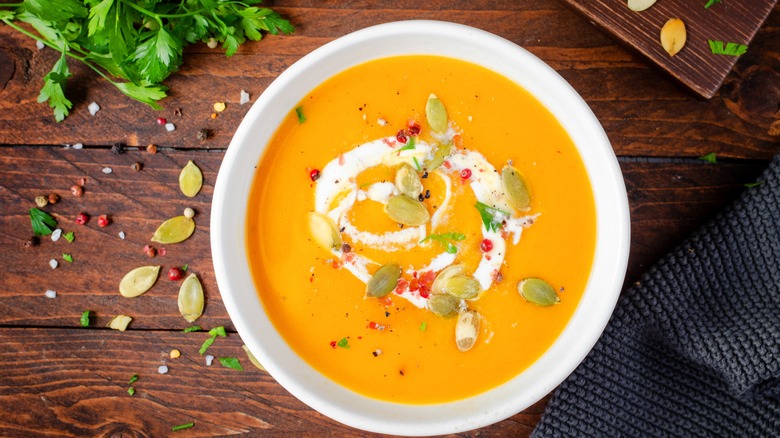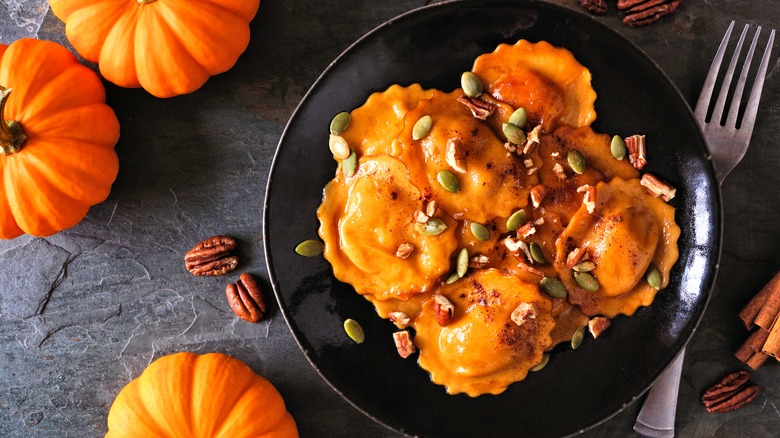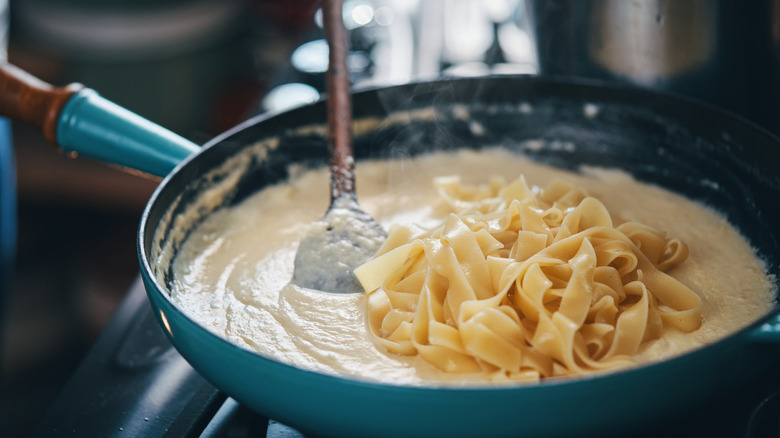Give Leftover Soup The Love It Deserves With A Simple Pasta Trick
It's safe to say that food lovers get as much pleasure from discussing their meals as they do from eating them. One might even go as far as to say that a sprinkling of controversy or a garnish of debate actually stimulates the appetite. Do beans belong in chili? Does pineapple go on pizza? Is a hot dog really just a long sandwich?
But when the crumbs settle, and there's a moment of clarity between friends, everyone suddenly realizes that many of those controversial takes are just semantics. Because food doesn't have hard rules and rigid boundaries; one person's empanada is another's samosa. That's why you have to let your guard down when you're playing around in the kitchen. Be silly. Have fun. Put ingredients together in a way that's not in a recipe book.
And the best way to start your culinary experiments is by transforming your leftover soup into pasta sauce. The main difference between the two is the volume of liquid. Add some boiling water to your jar of marinara or vodka sauce, and you'll have something that tastes pretty similar to a can of tomato soup. But you can push the boundaries so much further. A majority of soups, whether they're brothy, chunky, or cream-based, can make an excellent sauce for your next pasta night. All you need to know are a few techniques and which pitfalls to avoid.
How to turn soup into a superb pasta sauce
Soup and sauce are pretty similar and, therefore, fairly easy to use interchangeably. The three things to consider are volume of liquid, viscosity, and seasoning. As mentioned above, adding water to pasta sauce gives you something soup-like; however, the taste will likely fall flat, and the texture will be thin.
The same process works in reverse when turning a soup into a pasta sauce; instead of adding water, you evaporate moisture by simmering it over medium heat, thickening the soup, and concentrating the flavor. French cuisine is more or less built upon this technique. Many of the French "mother sauces," like espagnole or velouté, are essentially just stocks that have been reduced over low heat and thickened with a little flour and butter. For thicker soups, like a butternut squash bisque, carrot soup, or Moroccan lentil, you can thin out the consistency by adding a few splashes of pasta water or even some milk.
Speaking of dairy, when you work with a cream-based soup, like a cream of mushroom or cream of cauliflower, make sure you bring the temperature up slowly, or else you run the risk of the cream splitting, which is when the fat separates from the liquid, giving the soup an unappetizing, curdled look. Other than that, the only other aspect to focus on is seasoning your sauce. Punch up the flavor with spices, fresh herbs, or butter. And there you have it: Instant pasta sauce!
Best (and worst) soups to dress up your pasta
The great thing about pasta is that it pairs with a range of flavors, so when considering which soup-based sauce to pair with it, you're not bound by taste as much as you are by texture and consistency. Therefore, picking the right soup is more about eliminating the wrong ones. For example, eggy soups, like an egg drop or Greek avgolemono, tend to clump up when reheated. Noodle soups or soups filled with proteins also aren't great choices because the noodles tend to absorb some of the broth, and the meat, fish, or shellfish may overcook when it's reduced. Split pea and potato leek are also a little too starchy for a sauce, especially if you're using a thicker-shaped pasta.
So, which soups are worthy of a pasta sauce? Pretty much all of them! Tomato and minestrone are the obvious choices, but you can really branch out across the soup spectrum. For something more decadent, go with a cream of mushroom, asparagus, cauliflower, or even broccoli Cheddar. If you're making ravioli or another filled pasta, try a butternut squash soup or a pumpkin bisque. A lentil soup will add heft, while a white bean will provide smoothness. However, it's the Thai tom kha gai soup that makes for the most exciting sauce. The ginger, chili, and coconut milk bring a spice and richness that will inspire you to experiment with even more soup-based sauces.


